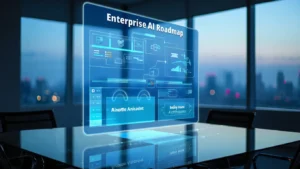AI Solutions for Logistics Cybersecurity
The logistics industry is rapidly evolving, with a significant portion of IT investment directed towards enhancing business intelligence, transportation management, warehouse operations, and supply chain visibility. However, a critical aspect seems to be missing from this focus—cybersecurity. Shocking findings from the State of Logistics Technology Report: 2019, published by EFT, reveal that only a fraction of logistics companies have dedicated Chief Information Security Officers (CISOs) in place. In fact, just 35% of solution providers and 43% of shipping companies have appointed CISOs, with a mere 21% of logistics companies believing they need one.
These concerning statistics highlight a glaring need for the logistics sector to prioritize cybersecurity. As the industry becomes increasingly digitized and interconnected, it also becomes more vulnerable to cyber threats. Fortunately, AI offers a promising solution to mitigate these risks. By leveraging AI technologies, logistics companies can bolster their cybersecurity measures, fortifying their systems against potential breaches and attacks.
Understanding the Challenges in Logistics Cybersecurity
In logistics, cybersecurity threats loom large, posing significant challenges to the industry’s smooth operation. Understanding these threats is crucial to fortifying defenses and safeguarding against potential breaches. Here, we delve into some specific cybersecurity challenges faced by the logistics sector:
Ransomware Attacks on Critical Infrastructure
Ransomware attacks have emerged as a major concern for logistics companies, targeting critical infrastructure such as transportation networks and warehouse management systems. These attacks involve malicious software that encrypts data or locks users out of their systems until a ransom is paid. For logistics companies, such attacks can lead to operational disruptions, financial losses, and compromise sensitive information, ultimately impacting customer trust and brand reputation.
Data Breaches Exposing Sensitive Information
With the vast amount of data generated and stored by logistics companies, data breaches present a significant threat. Hackers may exploit vulnerabilities in networks or applications to gain unauthorized access to sensitive information such as customer data, financial records, and supply chain details. The exposure of such confidential data not only poses a risk to individual privacy but also undermines the integrity of logistics operations, potentially leading to regulatory penalties and legal liabilities.
Supply Chain Disruptions Due to Cyber-Physical Attacks
Cyber-physical attacks target the interconnected systems that control physical processes within the logistics supply chain. These attacks can manipulate industrial control systems, autonomous vehicles, and other interconnected devices to disrupt operations, cause equipment malfunctions, or even endanger personnel safety. Such disruptions not only result in financial losses but also pose significant risks to public safety and national security.
Manipulation of Logistics Systems for Financial Gain
Another notable cybersecurity challenge in logistics is the manipulation of systems for financial gain. This may involve fraudulent activities such as invoice fraud, payment diversion schemes, or manipulation of shipping routes and delivery schedules. By exploiting weaknesses in logistics systems and processes, cybercriminals can siphon funds, divert shipments, or disrupt business operations, causing financial harm and eroding trust among stakeholders.
Despite the severity of these cybersecurity threats, traditional approaches to cybersecurity often fall short in addressing the unique challenges faced by the logistics industry. Traditional security measures such as firewalls, antivirus software, and intrusion detection systems are essential but may not provide sufficient protection against advanced and evolving threats. Moreover, the interconnected nature of logistics systems and the increasing reliance on digital technologies demand a more holistic and adaptive approach to cybersecurity.
Limitations in the Traditional Approach to Cybersecurity
Limitations of traditional cybersecurity approaches include:
Inability to Detect and Mitigate Sophisticated Attacks
Traditional security measures may struggle to detect and respond to advanced threats such as zero-day exploits, polymorphic malware, and targeted attacks tailored to exploit specific vulnerabilities in logistics systems.
Lack of Visibility and Control Across the Supply Chain
Traditional security measures often focus on securing internal networks and endpoints, overlooking the broader ecosystem of suppliers, partners, and third-party vendors that constitute the logistics supply chain.
Compliance and Regulatory Challenges
Compliance requirements such as GDPR, HIPAA, and industry-specific regulations add complexity to logistics cybersecurity efforts, requiring robust controls and mechanisms to ensure compliance across diverse geographies and jurisdictions.
Limited Scalability and Agility
Traditional cybersecurity approaches may be cumbersome to scale and adapt to the dynamic nature of logistics operations, hindering agility and responsiveness in the face of emerging threats and evolving business requirements.
AI Solutions for Logistics Cybersecurity
AI-powered solutions offer a multifaceted approach to addressing cybersecurity challenges in the logistics industry. Let’s explore how different AI-powered solutions effectively mitigate specific threats:
Anomaly Detection
Challenge
Logistics networks generate vast amounts of data from various sources such as sensors, IoT devices, and transaction logs. Detecting anomalies within this data, which may indicate potential security breaches or malicious activities, is a significant challenge.
Solution
AI algorithms, particularly those based on machine learning techniques like unsupervised learning, can analyze historical data to understand normal patterns of behavior within the network. By continuously monitoring incoming data streams in real-time, these algorithms can detect deviations from the norm, flagging them as potential security threats. This proactive approach enables security teams to respond swiftly to emerging threats and prevent potential breaches before they escalate.
Threat Intelligence
Challenge
The logistics industry is vulnerable to a wide range of cyber threats, including ransomware attacks, phishing attempts, and supply chain disruptions. Staying ahead of these threats requires timely access to accurate and actionable threat intelligence.
Solution
AI-powered threat intelligence platforms leverage machine learning algorithms to analyze vast amounts of structured and unstructured data from multiple sources, including open-source intelligence, dark web forums, and security incident reports. By identifying patterns and trends indicative of emerging threats, AI can provide logistics companies with timely alerts and insights, enabling them to proactively strengthen their defenses and mitigate risks before they materialize into full-blown cyberattacks.
Automated Incident Response
Challenge
Manual incident response processes are often slow and error-prone, leaving organizations vulnerable to prolonged disruptions and escalating damage in the event of a cyberattack.
Solution
AI-driven automated incident response systems can significantly accelerate response times by autonomously analyzing incoming threat alerts, correlating them with contextual information from internal and external sources, and executing predefined response actions in real time. These actions may include isolating compromised systems, blocking malicious IP addresses, or quarantining suspicious files.
By automating repetitive and time-consuming tasks, AI enables security teams to focus their efforts on more strategic activities, such as threat hunting and vulnerability management, thus enhancing overall cybersecurity effectiveness.
Cyber-Physical Security Integration
Challenge
As logistics operations become increasingly digitized and interconnected, the convergence of cyber and physical systems introduces new vulnerabilities and attack vectors.
Solution
AI-powered cyber-physical security solutions integrate with existing physical security systems, such as surveillance cameras, access control systems, and IoT sensors, to provide holistic protection against both digital and physical threats. By correlating data from digital and physical sensors, AI algorithms can detect anomalous activities that may indicate coordinated cyber-physical attacks, such as tampering with industrial equipment or unauthorized access to restricted areas. This integrated approach enables security teams to respond swiftly to potential threats, mitigating risks to personnel safety and operational continuity.
Blockchain Technology
Challenge
Ensuring the security and integrity of data within the logistics supply chain, particularly in multi-party transactions, is a significant challenge due to the risk of data tampering and unauthorized access.
Solution
Blockchain technology, combined with AI, offers a robust solution to enhance data security and transparency in logistics networks. By leveraging cryptographic techniques and distributed ledger technology, blockchain ensures the immutability and integrity of transaction records, making it virtually impossible for unauthorized parties to tamper with or manipulate data. AI algorithms can further enhance blockchain-based security by analyzing transaction patterns, identifying suspicious activities, and autonomously enforcing smart contract rules to prevent fraudulent transactions or unauthorized access to sensitive information.
This combination of blockchain and AI enables logistics companies to establish trust and transparency across the supply chain while protecting critical data assets from cyber threats.
Behavioral Analysis
Challenge
Traditional cybersecurity measures often struggle to detect insider threats or sophisticated attacks that exploit human vulnerabilities.
Solution
AI-driven behavioral analysis solutions analyze user behavior and activity patterns within the logistics network to identify anomalies indicative of potential security risks. By establishing baselines for normal behavior, AI algorithms can detect deviations that may suggest insider threats, compromised credentials, or unauthorized access attempts. This proactive approach enables security teams to intervene before security breaches occur, mitigating the impact of insider threats and human error on logistics operations.
Predictive Maintenance
Challenge
Cyberattacks targeting critical infrastructure within the logistics supply chain, such as transportation vehicles and warehouse equipment, can lead to operational disruptions and costly downtime.
Solution
AI-powered predictive maintenance systems analyze data from IoT sensors, equipment logs, and historical maintenance records to predict potential equipment failures before they occur. By leveraging machine learning algorithms, these systems can identify early warning signs of impending failures, enabling logistics companies to schedule proactive maintenance activities and prevent costly downtime caused by cyberattacks or equipment malfunctions. This enhances operational resilience and reduces the risk of cyber-related disruptions within the logistics supply chain.
Dynamic Risk Scoring
Challenge
Traditional risk assessment methodologies often rely on static criteria and periodic evaluations, making them ill-equipped to adapt to evolving cyber threats and changing business environments.
Solution
AI-driven dynamic risk scoring systems continuously evaluate the security posture of logistics operations based on real-time data and contextual insights. By analyzing factors such as threat intelligence feeds, network traffic patterns, and business process dependencies, AI algorithms can calculate dynamic risk scores that reflect the current threat landscape and operational context. This enables security teams to prioritize their efforts and allocate resources more effectively, focusing on areas of highest risk and greatest impact to mitigate cyber threats and safeguard critical assets.
Identity and Access Management (IAM)
Challenge
Managing user identities and access privileges across diverse systems and applications within the logistics network can be complex and prone to security gaps.
Solution
AI-powered IAM solutions leverage machine learning algorithms to automate the detection and remediation of identity-related security risks. By analyzing user behavior, access patterns, and authentication logs, AI can detect anomalous activities indicative of credential theft, unauthorized access, or insider threats.
Additionally, AI-driven IAM systems can adapt access policies dynamically based on contextual factors such as user location, device type, and time of access, ensuring that the right users have access to the right resources under the appropriate conditions while minimizing the risk of unauthorized access or data breaches.
Wrapping Up
It’s clear that AI solutions are game-changers when it comes to keeping our logistics networks safe from cyber threats. By using smart technologies like anomaly detection, threat intelligence, and automated incident response, we can stay ahead of the curve in safeguarding our data and operations. These tools give us the power to detect and neutralize threats before they become big problems, ensuring smooth and secure logistics operations.
As our industry continues to evolve, investing in AI-driven cybersecurity is a smart move to protect our assets and maintain trust with our partners and customers.
Ready to take your cybersecurity to the next level with AI? Partner with RTS Labs, your trusted AI consulting experts. Let’s fortify your logistics operations against cyber threats together. Contact us today to explore how AI can revolutionize your cybersecurity strategy.






